
One bench and lots of equipment already removed. Cardboard sheets taped up at right of center were to catch sparks and debris while using an anglegrinder to modify a bit of structural steel. Iron filings are the mortal enemy of electronics.
You wouldn't think buying a logic analyzer would lead to blasting a hand-held flame thrower into a red hot improvised furnace.
But that's what I was doing this evening, and why.
It went like this.
For some projects I have in mind I decided it was time to get a more modern logic analyzer, than my old HP 1630G. Which although I love it very much, was introduced sometime in the mid-1980s and has a max clock rate of 50MHz. And is therefore almost useless for a lot of high speed electronics systems today.
Other factors were that a friend of mine has a Tektonix TLA 715. And he's not well at all, unknown time to live. Apart from all the other sad aspects, I got pretty annoyed with myself for anticipating inheriting his logic analyzer. So to fix that, get my own one, now. Plus I'd recently started using a US reshipper, and it's been working out really well. Now I can purchase large items from the USA, and not get completely killed by the freight costs.
I should mention that I also have a bit of a 'data generation and analysis' fetish, like some people collect oscilloscopes. Or multimeters. I try not to indulge this urge to buy old junk too much, but... thinking of buying an actual, fairly recently top-of the line logic analyzer - sigh. Imagine Homer Simpson imagining chocolate donuts. Fresh, delicious donuts, with icing. With that donut smell. And sprinkled with hundreds and thou.... um, you get the idea.
Anyway, so I got a TLA 614 quite cheaply, including a full set of probes. What I'd really have liked was a TLA 721, which was the absolute top of the line instrument till not many years ago. I'd looked at ebay prices of the mainframe TLA 700 series, and decided I couldn't afford one of those at current prices. In the course of all this it became clear that Tektronix have turned into the kind of company that does software crippling of hardware, and there's an interesting puzzle associated with the entire TLA series. To do with options, and where the 'unlocking' data is stored. With a related issue, that they all use a Dallas NVRAM module to store something, and the batteries of those soldered-in NVRAMs in all Tek TLA 600-series analyzer models from the early 2000's are due to start dying around about now.
So I was wishing I could have afforded a modular mainframe TLA 700 series unit, since it would be useful to experiment with modules and their options, rather than risk destroying a whole (and my only modern) logic analyzer.
Recently I'd found that US sellers quite often accept offers much lower than their item list price. Sometimes even if they didn't include the 'Make an offer' listing option. Maybe it's hard economic times, or maybe they just need to shift gear out. (I suspect the former.) Anyway just for the heck of it I made a very low offer on a nice looking TLA 721. Unexpectedly I got it, for near to my initial offer!
Ah. Well that's a bit awkward. You see it was already obvious even before the TLA 614 arrived, that my electronics workspace is seriously inadequate. There'd been plans in the back of my mind for ages to improve the setup, but I'd never found time. Now if I'm going to have TWO logic analyzers (one for looking at the other, at least for a while), then there's no choice - the building upgrade has to be first.
The space I had to work with:

One bench and lots of equipment already removed. Cardboard sheets taped up at right of center were to catch sparks and debris while using an anglegrinder to modify a bit of structural steel. Iron filings are the mortal enemy of electronics.
The workspace objectives:
Problems:
Stage 1: Getting a good solid 19" rack cheaply. It was too deep, so I cut it in half vertically, removed a section, welded it back together and refinished it. Then constructed a wheeled base with screw-down floor posts for stability. Finally mounted the equipment in it, for its intended function. That was crucial since with the space shortage having those big pieces of gear piled up pretty much brought the whole room to a wedged state.
Stage 2: Dismantle my present workbench setup, stack everything on the other side of the room, and figure out how to make the shelves work structurally. My main work PC was among the stacked gear.
At this point Murphy saw his opportunity. In rapid succession:
Finally all that settled down, and the first (smaller) shelf set was finished.
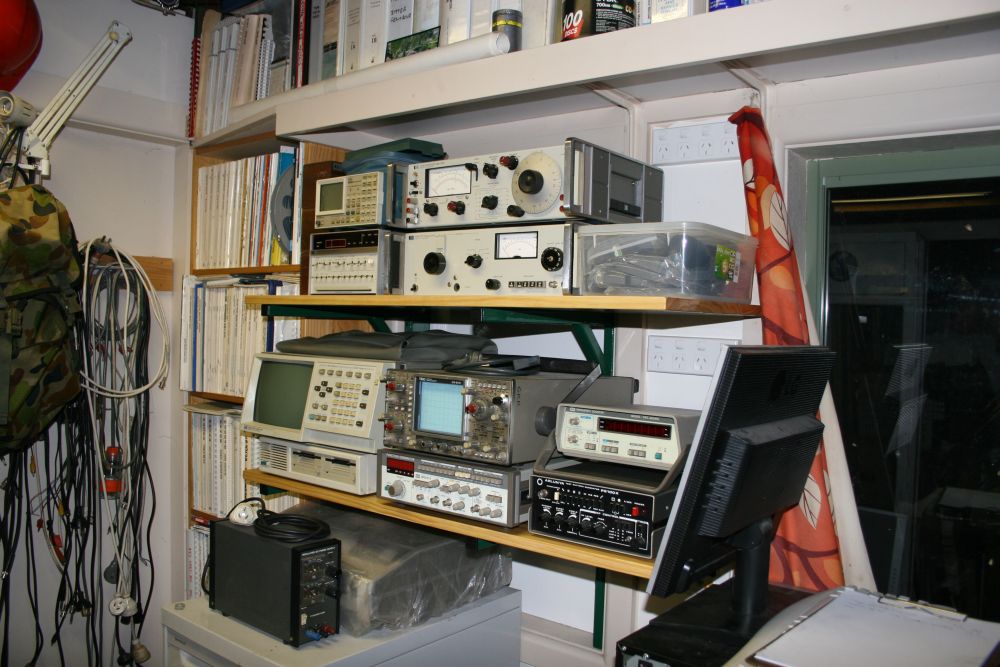
It may not look like much. But it took a bit of work:
 |
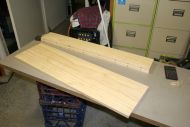 |
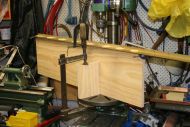 |
 |
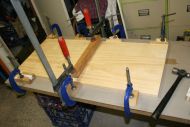 |
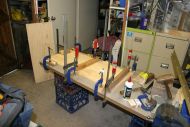 |
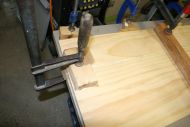 |
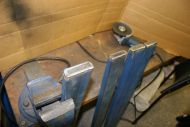 |
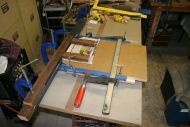 |
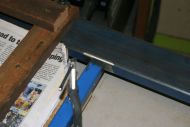 |
 |
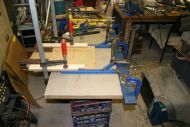 |
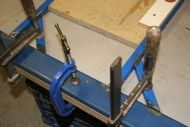 |
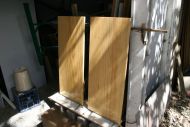 |
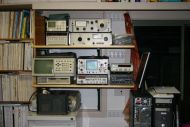 |
Meanwhile there'd been some hair-tearing drama with shipping the TLA 721. Before then every single item I'd put through the reshipper had gone flawlessly. So of course for the most expensive, precious, biggest one, something had to go wrong!
The box was the largest yet - a 26" per side cube, weighing 71 lbs. For some reason the shipping quote from Fedex (via the reshipper, so discounted for bulk) was quite a lot cheaper than the other carriers - something I'd not seen before. So I gave them a go, and had it sent Fedex Economy.
Now the reshipper's warehouse is in Los Angeles, one mile from LA International Airport. That's the whole point, and one reason why carriers like TNT give such low quotes via shipito.
So what did FedEx do? After pickup from shipito they sent it 300 miles north, apparently by truck overnight, to San Francisco. Where it then stayed for a couple of days. Then they got it on a plane - to Hawaii. Where it sat for a couple more days. Then finally to Sydney, and Fedex's facility in Alexandria near the airport.
'Oh good' I thought, 'I'll get it tomorrow.' I'm about 20 minutes drive South from there, in the Bankstown area. Very direct via the M5 expressway. But no... the next day FedEx trucked it North, the opposite direction and also further, to their Rydalmere facility. With the tracking web page stating 'not due for delivery'.
Finally, the day after that they trucked it South again, and it actually arrived.
I'd been freaking out, expecting that with so much stupidly unnecessary handling and trucking it would very likely be damaged.
A great relief to find it had survived!
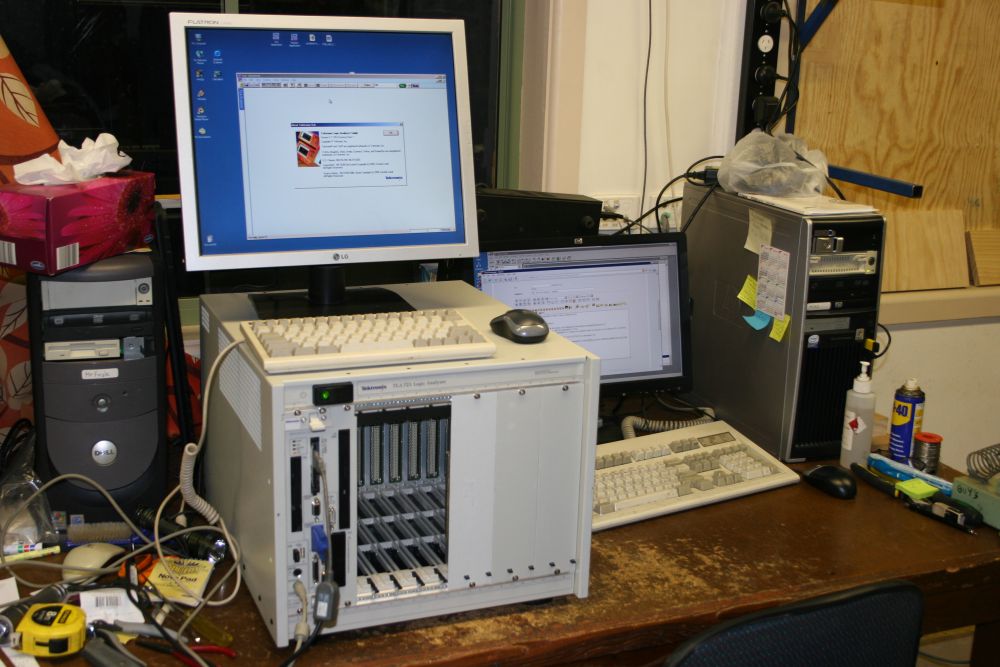
No modules fitted yet, but the mainframe works!
There was an amusing but very much appreciated bonus. The seller had listed it as "Boots to Windows login, but we don't know the password." So on booting I tried the obvious defaults - "password" and so on. Nope. Sigh, well I expected I'd have to reinstall the system anyway. Then with no hope of success I tried [enter] ie no password at all. Ha! It worked! I think the seller's 'didn't know password' was another factor in getting it cheaply too.
As for Fedex, it would seem they feel the need to run an 'economy' rate that is competetive with other carriers like TNT. But to make sure their high-paying customers accustomed to FedEx's normal service don't get the idea that FedEx could do the same for lower rates, FedEx's 'ecomomy' service involves ridiculous routing and deliberate delays.
During that interval I'd also bought three TLA modules and an assortment of probes. For a while those were all still at the reshipper, being consolidated for the next shipment. (They arrived at my door on 20131028.)
Frustratingly, the right hand shelf set still isn't finished. Because one end-support for that shelf set had to solve an odd geometry problem caused by the existing building arrangement. Which resulted in needing to weld stubs on the flat face of the main rectangular steel vertical. That's not good.

Preparing to weld the stubs. You know what's going to happen, right? (Hint: weld bead metal contracts as it cools. A lot.)
I knew those welds would warp the beam, but was surprised by how much. Not pear but banana shaped. Sigh...
So now a difficult problem - how to straighten a really strong but bent steel beam?
I tried just heating up the bent areas in the workshop with an oxy torch, and forcing it straight while maleable. Nope... the metal section is too large, and I can't get enough heat evenly over the entire area. I could change the degree of bent-ness, but because the beam was unevenly heated, I couldn't get it so it would be straight once it cooled.
Stumped.
Gee, what I need is some kind of furnace, to heat the entire beam section evenly. Which is funny, since my other workshop, the most incomplete one, is supposed to be for metal casting, furnaces, etc. So I have a big pile of firebricks stacked in there. And some f*ck-off sized blowtorches, suitable for heating furnaces.
Well, the huge oil-burner one is too big. I want to heat the beam up, not melt it down in seconds. The best one is probably um... the one that I don't have an adapter for yet, to run it off a propane cylinder. So, more running around and dealing with the carefully deliberate official unavailability of adapters from LPG fittings (reverse threaded) to standard plumbing fitting threads. Because we wouldn't want people to be able to just make up gas plumbing from stuff they could buy at Bunnings, now would we? (Grrrr, nanny-State, etc)
That problem solved by joining two different bought pieces together via the lathe and some silver soldering.

Spot the joint in the brass fitting.
On first trying the torch, Awwww yissss! I like! A hand held rocket engine, cool. It was probably intended for natural gas, so tends to blow out if run at high pressure from an LPG tank. Meaning that a) it must be used outside, and b) it must be used with a smaller blowtorch as a 'pilot light'. Never mind. What was a problem was the total fire ban, plus although I'd be running a gas flame in a 'furnace', in bright daylight flame (burning grass, dry leaves, clothing, etc) is almost invisible. Don't want to start any major fires and burn people's houses down. I'll leave that to the Australian Army. (Jerks!)
So it had to wait till dark.
By evening I had a construction of firebricks enclosing the bent beam, the big gas torch and a small one, the tools for 'adjusting' the red hot beam, and everything else all ready. Including a garden hose and the nearby flamables all wetted down.
This is how it went.
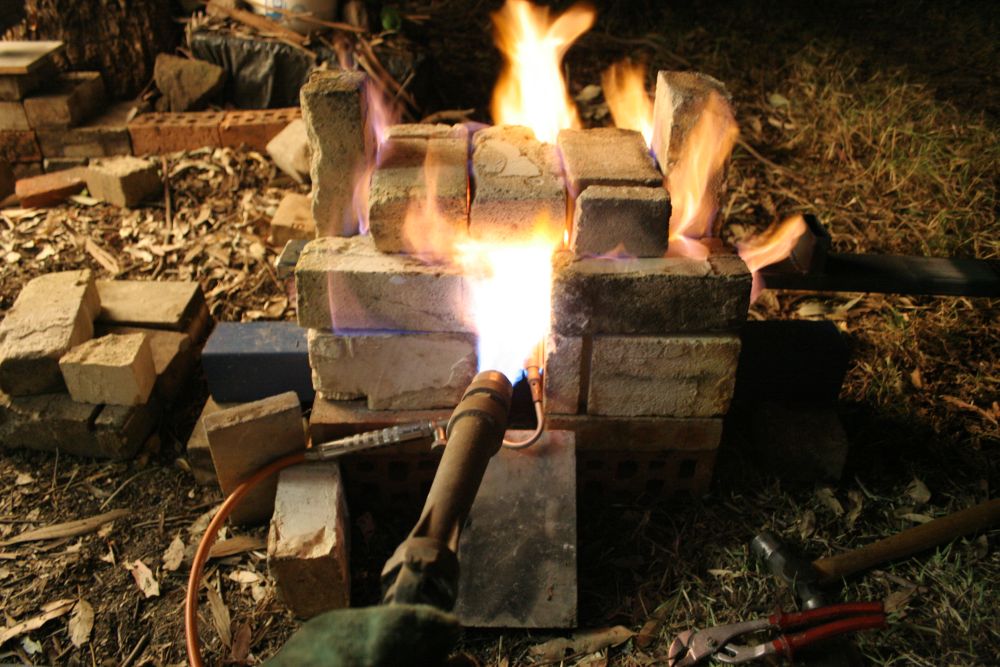
The point about firebricks is not that they can take heat, but that they are a ceramic foam that is quite a good thermal insulator. So the surface exposed to the flame heats up quickly, and re-radiates the heat back towards the source. This means that you can enclose a space with firebricks, and with a moderate input of heat the entire interior will become about equally hot. It doesn't matter if there are cracks. In fact there must be outlets for the combustion products, or the flame can't heat the interior effectively. So all the flames 'leaking' out here are not a problem.
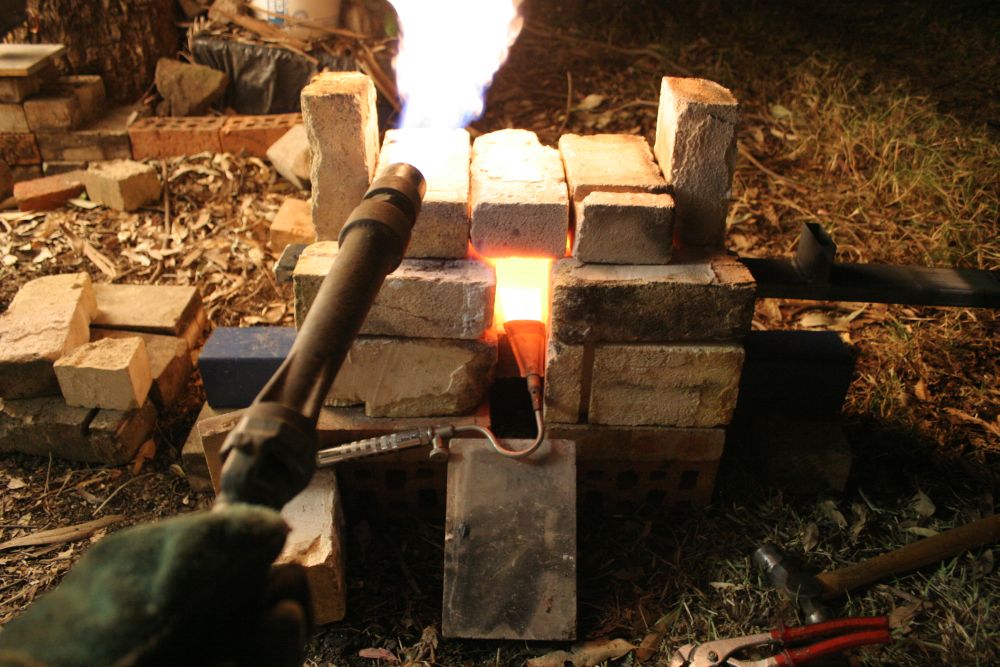
After a few minutes the entire inside, steel beam included, is a nice cherry red. The small torch is for keeping the big one alight, and also providing 'keep warm' input when I remove the big one to see how things are going.

Closer. You can just see the steel beam inside.
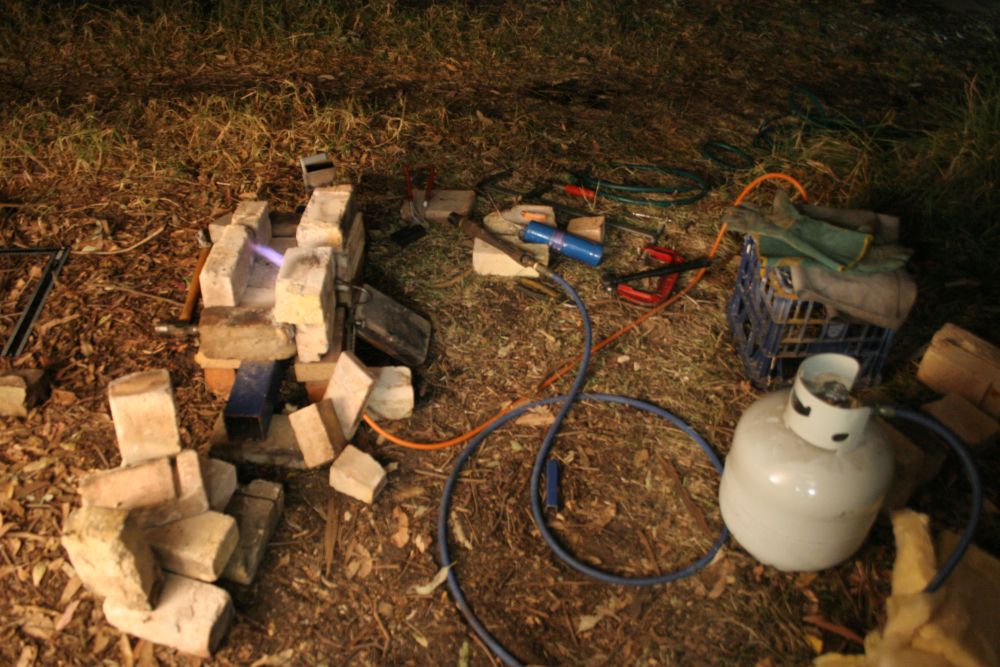
After pulling the beam out. It's end on to the camera, resting on the bricks.
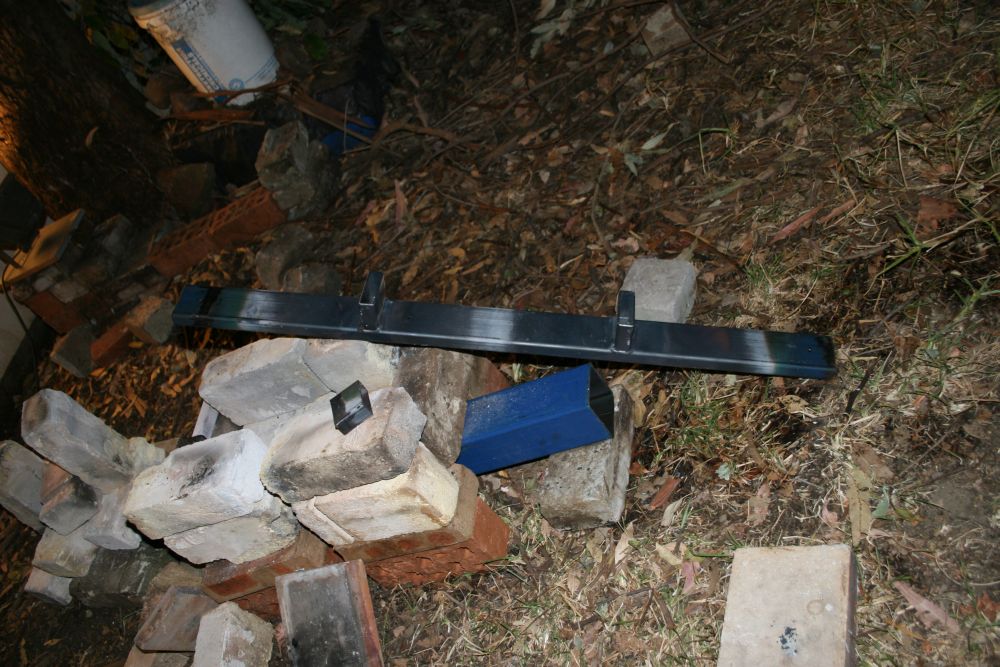
Cooling down.
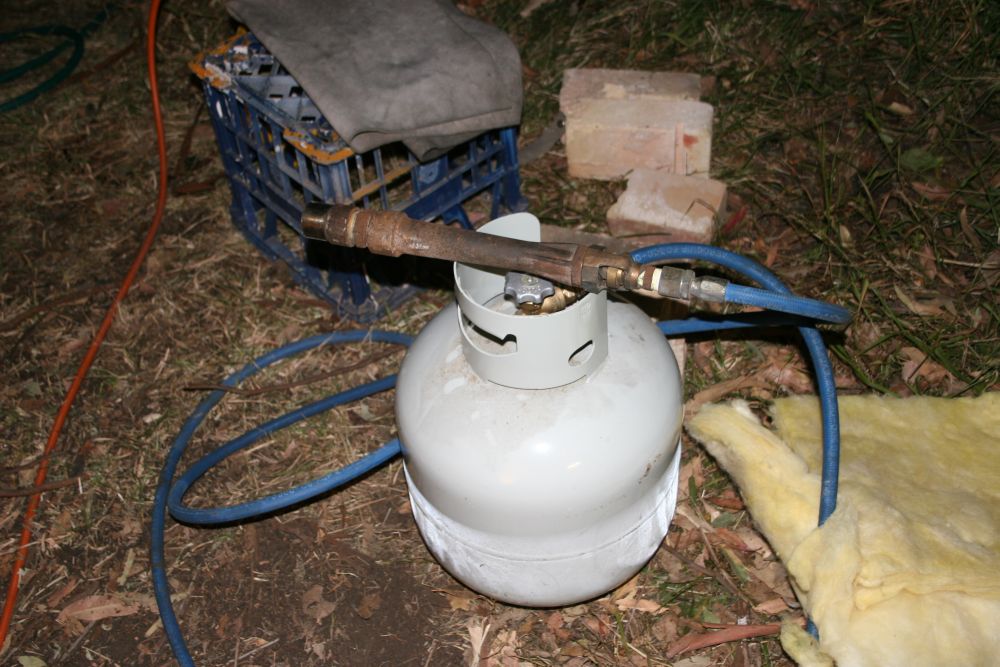
The torch. Note the condensation around the gas cylinder, due to the high rate of gas draw and thus boiloff of the liquid propane. When using burners like this off small propane cylinders for much longer than I did here, it's necessary to immerse the cylinder in a tub of water, so a) the propane is kept warm enough to give a good boiloff rate, and b) avoid getting the cylinder metal too cold, which could be dangerous.
I'd first intended to use a big G-clamp to apply force to the red-hot beam to straighten it, but that didn't work due to not having a solid G-clamp big enough, and secondly because using a woodworking clamp meant having to hold the handle too close to a lot of red-hot surfaces. The clamp was too weak, my hand couldn't take the heat, gloves slipped on the wood, and the clamp wooden handle would have caught fire soon enough.
The fallback was to use a big hammer, in the Russian style. That worked.
So that was it. Done! Just a little more work over the next few hours weeks to get the right hand shelves up....
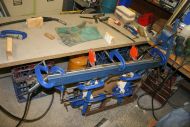 |
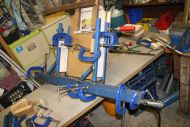 |
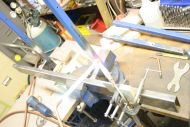 |
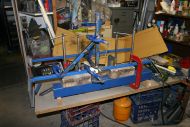 |
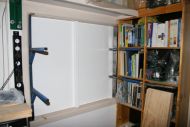 |
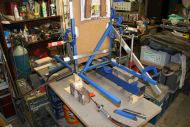 |
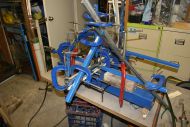 |
 |
 |
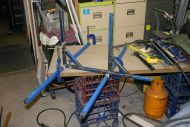 |
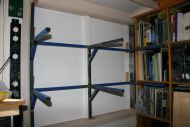 |
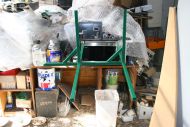 |
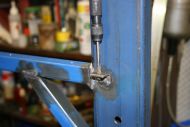 |
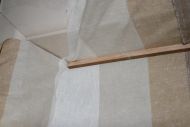 |
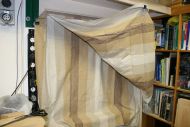 |
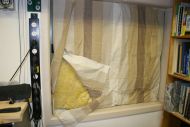 |
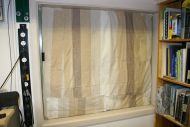 |
 |
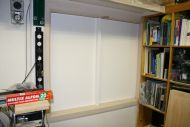 |
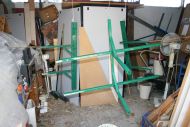 |
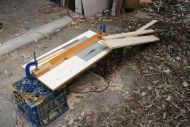 |
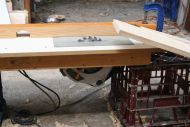 |
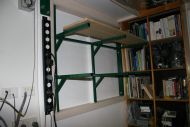 |
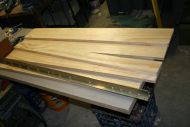 |
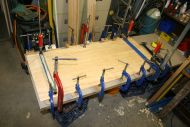 |
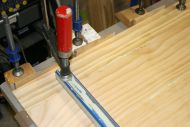 |
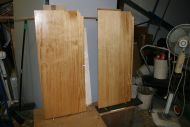 |
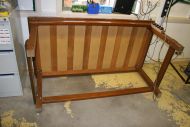 |
 |
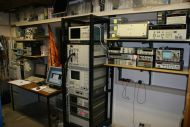 |
Which just leaves a couple of benches to build, some cabling to install, a better lighting system, another set of shelves on another wall, a thing over to the left to organize a bunch of battery & laptop chargers, scanner, EPROM eraser, NAS box, USB HD dock, then some more cable hooks, assorted equipment that needs repair...
Ha ha... Actually my 'to do' list, which I keep on loose A4 sheets (of photocopy paper) in a clipboard, is currently 18 pages long. Most of them full of handwritten one-line points. Some sheets are just a mix of general tasks, some relate to specific projects and their stages. Very active projects tend to get allocated their own clipboard; projects that are complex but not so active get their sheets transfered between clipboard and filing cabinet folders as needs arise.
Where projects require any electronic data organization, they have files on computer. But for day to day task lists I find pencil and paper far more effective than messing around with any form of gadgetry. Simple, quick, flexible, no chance of glitches or information loss, always on, survives messy workshop environments, nothing to break, no batteries or cords, free format and intrinsic ability to mix text and sketches, erasability, no issues with data retention, software version compatibility, auto-updates, power-loss, viruses and other people's horrible ideas about GUI visual styling - you absolutely can't beat pencil and paper. Engineer's propelling pencils, 0.5mm leads, 2B hardness. I like it, and have bought a lifetime supply.
On the sheets, items get crossed off as I finish them, and completed pages get filed away in a master 'Done' folder (or project files) as a kind of ad hoc diary. (I always date the sheets, so they do form a useful sequential record.) Crossing stuff off and eventually archiving sheets provides one of those small rewards in life, that help fight off the dark futility clouds.
Hopefully eventually I'll actually get to use those logic analyzers.